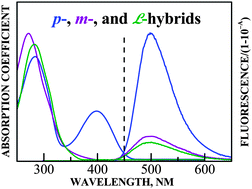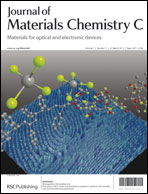Evaluation of propylene-, meta-, and para-linked triazine and tert-butyltriphenylamine as bipolar hosts for phosphorescent organic light-emitting diodes†
Abstract
Three representative bipolar hybrids – tBu-TPA-p-TRZ, tBu-TPA-m-TRZ, and tBu-TPA- -TRZ with triplet energies, ET = 2.5, 2.7 and 3.0 eV, respectively – were synthesized and characterized for a comprehensive evaluation of their potential as a host for phosphorescent organic light-emitting diodes (PhOLEDs) using red-emitting Ir(piq)3 as the dopant with an ET value of 2.1 eV. Formation of charge transfer complexes, CTCs, was diagnosed by fluorescence bathochromism in increasingly
-TRZ with triplet energies, ET = 2.5, 2.7 and 3.0 eV, respectively – were synthesized and characterized for a comprehensive evaluation of their potential as a host for phosphorescent organic light-emitting diodes (PhOLEDs) using red-emitting Ir(piq)3 as the dopant with an ET value of 2.1 eV. Formation of charge transfer complexes, CTCs, was diagnosed by fluorescence bathochromism in increasingly  -hybrid is the least prone to CTC formation while suffering charge flux imbalance to yield an EQE intermediate between those of the mm- and ppp-hybrids. The least CTC formation involving the
-hybrid is the least prone to CTC formation while suffering charge flux imbalance to yield an EQE intermediate between those of the mm- and ppp-hybrids. The least CTC formation involving the  -hybrid is advantageous in accommodating the most singlets and triplets readily transferrable to both red and blue phosphors on account of its relatively high ET value. Furthermore, the
-hybrid is advantageous in accommodating the most singlets and triplets readily transferrable to both red and blue phosphors on account of its relatively high ET value. Furthermore, the  -hybrid offers the best morphological stability of the desired glassy EML, thus holding promise for the fabrication of superior PhOLEDs overall.
-hybrid offers the best morphological stability of the desired glassy EML, thus holding promise for the fabrication of superior PhOLEDs overall.


 Please wait while we load your content...
Please wait while we load your content...